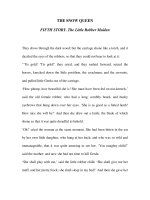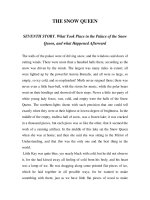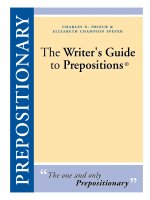Tài liệu The Passive Voice docx
Bạn đang xem bản rút gọn của tài liệu. Xem và tải ngay bản đầy đủ của tài liệu tại đây (265.6 KB, 47 trang )
The Passive Voice
In other sections, you have seen verbs used in the active voice. The passive voice is
sometimes used in English as well. With the active voice, the agent or subject comes
before the verb. With the passive, the subject (either stated or implied) follows the verb
and is usually preceded with the word by:
ACTIVE:
--The doctor wrote a prescription.
PASSIVE
--The prescription was written by the doctor.
NOTE: In the passive, the object of the active verb becomes the subject.
To make the passive, use the appropriate form of the verb to be + past participle. Only
transitive verbs are used in the passive:
ACTIVE: Fred helps Jane.
PASSIVE: Jane is helped by Fred.
ACTIVE: He is helping her.
PASSIVE: She is being helped by him.
ACTIVE: He has helped her.
PASSIVE: She has been helped by him.
ACTIVE: He helped her.
PASSIVE: She was helped by him.
ACTIVE: He was helping her.
PASSIVE: She was being helped by him.
ACTIVE: He had helped her.
PASSIVE: She had been helped by him.
ACTIVE: He will help her.
PASSIVE: She will be helped by him.
ACTIVE: He is going to help her.
PASSIVE: She is going to be helped by him.
Usually the by phrase is omitted in a passive sentence. The passive is used mainly when
it is not known or not important to know who was responsible for the action:
--The house was built in 1960.
(The by phrase is left out because it is understood that builders
built the house).
Using A Few, Few, A Little, and Little
A few and few are used with plural count nouns:
--a few friends, few ideas, a few things to do, etc.
A little and little are used with noncount nouns:
--little money, a little rain, a little wind, etc.
NOTE: Few and little give a negative idea, conveying the notion that something is
largely absent:
--They have very little money.
--We have few options remaining.
NOTE: A few and a little give a positive idea, indicating that something exists or is
present:
--I have a little free time today.
--Do you have a few moments?
Placement of Adjectives and Adverbs
Adjectives and adverbs are invariable in English. Adjectives always come in front of
the noun they modify. Adverbs usually come after the verb they modify.
ADJECTIVES:
a good book
an excellent dinner
a fine wine
a charming person
a hot day
an unreasonable person
ADVERBS:
--This newspaper is published frequently.
--The Immigration Agent is speaking quickly.
Forms of Other
Forms of other are used as either adjectives or pronouns:
SINGULAR: another book
(is)
another is
PLURAL: other books
(are)
others (are)
SINGULAR: the other
book (is)
the other (is)
PLURAL: the other
books (are)
the others
(are)
Note that a final -s is used only for a plural pronoun (others). Another means one more
in addition to the one(s) already mentioned. Other/others (without the) refer to several
more in addition to the one(s) already mentioned. The other(s) has a different meaning
(all that remains from a given number or specific group):
--I have three apartments. Two are mine. The other is yours.
Indefinite and Definite Articles
There is no need to worry about whether a noun is masculine, feminine, or neuter in
English. Normally, a noun is preceded by a definite article (THE) or an indefinite
article (A, AN) as follows:
DEFINITE ARTICLE
the tourist
the area
the card
the hotel
the restaurant
the people
the signs
INDEFINITE ARTICLE
a tourist
an area
a card
a hotel
a restaurant
some people
some signs
Note that definite articles refer to something specific, while indefinite articles refer to
something non-specific. Use an in front of words beginning with vowels and some with
plural nouns.
Using Some and Any
In English the words some and any are used before plural nouns: some money, some
dollars, any change, etc.
However, it is often possible to leave out the word some in declarative sentences:
--We have (some) checks.
--Mr. Roberts gives them (some) money.
The word any is usually used in questions and negations to replace some:
--Do you have any change?
--Do you have some change?
--They don't have any friends.
Imperatives (The Command Form)
It is simple to use the imperative or command form in English. When a command is
directed at someone else, use the you form of the simple present tense:
--You take the elevator.
-->Take the elevator.
(Simply drop the subject you.)
If the command includes you and others, use the we form:
--We take our luggage.
-->Let's take the luggage.
(Drop the subject we and add let's [let us].)
Using Comparisons
There are two ways to make a comparison in English.
1.) Use more in front of the adjective.
--It's more exciting.
2.) Add -er to end of the adjective.
--A bus is cheaper than a taxi.
To complete a comparison, use than.
--I am older than my wife.
For most one-syllable adjectives, use -er: older, wiser, etc. For most two and three-
syllable adjectives, use more: more recent. For two-syllable adjectives ending in -y, use
-er. Note that the y is changed to i in words such as busy (busier) and pretty (prettier).
It is sometimes hard to decide whether to use more or -er in a comparison. In fact, there
are many common adjectives that use either form (such as able, angry, cruel, friendly,
polite, quiet, simple, etc.). Listening and practice with speaking the language will help
you more than any number of rules. Finally, note the following irregular forms:
good-->better
little-->less
bad-->worse
far-->farther
Adverbs can also be used in comparisons. More is used with adverbs that end in -ly:
slowly-->more slowly
careful-->more carefully
Use -er with one-syllable adverbs: faster, harder, sooner, closer, etc.
Note these irregular forms:
well-->better
far-->farther
badly-->worse
Using Conjunctions
Here are some conjunctions that are frequently used in subordinate clauses:
TIME CAUSE &
EFFECT
after because
before since
when now that
while as
as as/so long as
since inasmuch as
until so (that)
as soon as in order that
once
as/so long as
OPPOSITION CONDITION
even though if
although unless
though only if
whereas whether or not
while even if
providing
(that)
provided (that)
incase (that)
in the event
(that)
When a conjunction is used with a subordinate clause, the construction is called an
adverbial clause.
Here are some adverbial clauses that relate to time:
--After we leave the bank, we'll spend the money.
--When they arrived, they sat down to dinner.
--We haven't seen her since she left.
And here are clauses that show cause and effect relationships:
--Since you didn't call, I made other plans.
--He went to bed, because he was tired.
Another way to show a cause and effect relationship is to use such... that and so... that:
--It was such a nice evening that they stayed up too late.
--The lemonade was so cold that she couldn't drink
Using When
Previously, you learned how to use when in questions :
--When are you leaving?
When can also be used in a dependent clause:
--I forgot the date when you arrived.
In the latter example, when is used to refer to a noun of time (i.e., a day, week, month,
etc.)
In time clauses, it is also possible to use that or which preceded by a preposition:
--I forgot the date that you arrived.
--I forgot the date on which you arrived.
No preposition is needed with that.
Note how two sentences are combined using when:
--I'll always remember the day she was born. She was born then (on that day).
--I'll always remember the day when she was born.
Using Where
Earlier in this course, you learned how to use where in questions :
--Where are you going?
Where can also be used in a dependent clause:
--I see the house where they live.
In the latter example, where is used to refer to a place, such as a city, state, country,
room, etc.
NOTE: In dependent clauses, where can be replaced with in which, which ... in, that ...
in, or nothing at all:
--The building where they work is new.
--The building in which they work is new.
--The building, which they work in, is new.
--The building that they work in is new.
--The building they work in is new.
Contractions
You will want to learn how to use contractions as soon as possible. Contractions are
used constantly in informal English. Examples of contracted subject/verb forms are:
TO BE:
I am-->I'm
he is-->he's
we are-->we're
you are-->you're
they are-->they're
TO HAVE:
I have-->I've
we have-->we've
you have-->you've
they have-->they've
Contractions are frequently used with compound forms of verbs, especially the
progressive or continuous form of the present tense (I'm going. / We're leaving.) and the
present perfect forms (I've received the letter. / They've already left.)
A later lesson will deal with the compound forms of verbs in greater length
Exclamations!
Most exclamations in English are preceded by what or how:
--What terrible weather!
--How awful!
What is used much more frequently than how in everyday language.
Exclamations can be as brief as one or two words (What a mess!) or as long as a
sentence:
--What a way to end my vacation!
NOTE: Don't forget that what and how are most frequently used in questions:
--What did you say?
--How much does it cost?
Asking Questions
In English, you can ask simple yes/no questions by either inverting the subject and verb
or by using rising intonation:
--We can change money here.
(simple, declarative statement)
--Can we change money here?
(question with verb first)
--We can change money here?
(question with rising intonation)
NOTE: In the case of the simple present tense, it is necessary to use a form of the verb
to do as an auxiliary in making a question:
--They like this bank.
-->Do they like this bank?
--You have a passport.
-->Do you have a passport?
Interrogatives in Dependent Clauses
In the dialogue for this chapter, you see:
--Do you know where I can cut off the water? (correct)
This construction can be troublesome for learners of English, because there is a
tendency to make the dependent clause (where I can cut off...) a question as well:
--Do you know where can I cut off the water? (incorrect)
Both do you know and where can I cut off the water are legitimate questions when used
separately. However, when combined in a single sentence the main clause (Do you
know...) carries the full weight of the interrogative.
Here are some additional examples:
--Do you see it? Where is it?
-->Do you see where it is?
--Do you know when? When does he arrive?
-->Do you know when he arrives?
Information Questions
Many times you will want to ask a question that elicits information, instead of a simple
yes/no answer. Information questions will begin with one of the following words:
WHO
WHERE
WHOM
WHAT
WHOSE
WHICH
WHY
HOW
WHEN
Who refers to people. It is used as the subject of the question.
Whom is used as the object of a verb or preposition.
Whose asks questions about possession.
Why is used to ask questions about reason.
When is used to ask questions about time.
Where is used to ask questions about place.
What can be used as the subject or object of a question. It refers to things.
Which is used instead of what when a question concerns choosing from a definite,
known quantity or group.
How generally asks about manner. It is often used with much and many.
When a form of to be is the main verb in the simple present and simple past, it precedes
the subject:
--Who is that man?
--Where is the airport?
--Where are the checks?
--What time is it?
Negative Questions
In a yes/no question in which the verb is negative, usually a contraction is used:
--Doesn't she live with you?
The other form, which is not contracted, is considered formal and is rarely used in
everyday speech:
--Does she not live with you?
To form a negative question, make the auxiliary negative by adding not:
--Do they cash traveler's checks?
--> Don't they (Do they not) cash...?
HERE ARE SOME MORE EXAMPLES:
--Is Mr. Jones here?
-->Isn't Mr. Jones here?
--Are you coming?
-->Aren't you coming?
Tag Questions
Tag questions are questions that are added at the end of a sentence.
--Mary is here, isn't she?
--You like beer, don't you?
--They are leaving, aren't they?
--She doesn't drink coffee, does she?
--He has brown hair, doesn't he?
The subject of the tag question should be the same as the subject of the main verb. If the
first part of the sentence is in the affirmative, then the tag question will be negative, and
vice versa.
FIRST PART
OF
SENTENCE:
TAG
QUESTION:
affirmative negative
negative affirmative
In American English, a form of do is usually used when have is the main verb: They
have change, don't they?
Negatives
The word not is used with do to make a verb negative, as in I don't have any money
(don't = do not). No is used as an adjective in front of a noun, as in I have no money.
Both of these examples are acceptable ways of expressing the idea that you do not have
something.
Note these contracted negative forms with do:
I don't
you don't
he, she doesn't
they don't
we don't
Here are some affirmative words and their negative forms in English:
AFFIRMATIVES
someone, anybody
something, anything
still
ever
either... or
NEGATIVES
no one, nobody
nothing
no longer
never
neither... nor
Avoid using more than one negative in a clause:
--I don't have any money.
NOT: I don't have no money.
--They don't see anybody.
NOT: They don't see nobody.
--I didn't do anything.
NOT: I didn't do nothing.
Count And Noncount Nouns
Count nouns are nouns that can be counted (e.g., a book, two friends, three cars, etc.).
A count noun may be preceded by a or an in the singular; it takes a final -s or -es in the
plural.
Noncount (or mass) nouns refer to things that cannot be counted (e.g., money, rain,
snow, butter, wind, air, clothing, etc.). Noncount nouns are not preceded by a or an and
have no plural form.
COMMON NONCOUNT NOUNS
advice weather equipment
news water jewelry
information music postage
work money luggage
Some nouns can be both count and noncount nouns:
--We drank some wine. (Noncount)
--We ordered three wines. (Count)
(It is implicit that three different wines were ord
Irregular Noun Plurals
When the final -y is preceded by a consonant, change the -y to -i and add -es:
baby-->babies
lady-->ladies
If a noun ends in -fe or -f, the ending is changed to -ves (except: beliefs, chiefs, roofs,
staffs).
life-->lives
thief-->thieves
Add -es to nouns ending in -sh, -ch, -s, -z, and -x. (Exceptions: monarchs, stomachs.)
wish-->wishes
class-->classes
Both the -s and -es spellings are accepted for nouns ending in -o.
tomato-->tomatoes
hero-->heroes
The plural possessive form of these nouns is also irregular.
child-->children
foot-->feet
goose-->geese
man-->men
tooth-->teeth
The plural is the same as the singular for these nouns.
deer-->deer
fish-->fish
sheep-->sheep
species-->species
The final sound of these plurals is pronounced like the word sees.
crisis-->crises
thesis-->theses
Singular and Plural Forms of Nouns
All English nouns are either singular or plural. Most words form the plural by adding an
-s to the end of the singular form:
month-->months
visa-->visas
airport-->airports
Other words, already referring to more than one person or thing, do not normally add an
-s.
--the people, the fish, the mice, etc.
Expressing Opposition
Here are some ways to show opposition when the result is the opposite of what you
might expect:
1. ADVERB CLAUSES
even though
although
though
--Even though it was hot, we wore our coats.
2. CONJUNCTIONS
but ... anyway
but ... still
yet ... still
--It was cold, but we still went swimming.
3. PREPOSITIONS
despite
in spite of
--They went skiing despite the warm temperatures.
Here are words that show direct opposition:
1. ADVERB CLAUSES
whereas
while
--Paul is tall, whereas Richard is short.
--While Sue is industrious, Marie is lazy.
2. CONJUNCTION
but
--The travel agent is tired, but she is still working.
3. TRANSITIONS
however
on the other hand
--Carole is beautiful, however, she doesn't dress very well.
Whereas and while are used to show direct opposition; it does not make any difference
which idea comes first and which second; the same rule applies for but / however / on
the other hand.
Possessive Adjectives
Here are the possessive adjectives in English:
1st person, singular -- my
3rd person, singular -- his, her, its
1st person, plural -- our
2nd person, sing./pl. -- your
3rd person, plural -- their
In English, the gender and number of the possessor determines the form of the
possessive adjective:
--I have a credit card. It's my credit card.
--She has some money. It's her money.
NOTE: Often the subject of the verb is not the person who owns the noun. Be careful
about this. You must know the gender and number of the owner to be able to use
possessive adjectives correctly:
--Are you buying his ticket or her ticket?
--I'm buying his ticket.
Possessive Pronouns
Here are the possessive pronouns in English:
1st person, singular -- mine
3rd person, singular -- his, hers, its
1st person, plural -- ours
2nd person, sing./pl. -- yours
3rd person, plural -- theirs
In English, the gender and number of the possessor determines the form of the
possessive pronoun:
--I have a bicycle. It's mine.
--They have some bread. It's theirs.
NOTE: Often the subject of the verb is not the person who owns the noun. Be careful
about this. You must know the gender and number of the owner to be able to use
possessive pronouns correctly:
--Are you driving his car or hers?
--We're driving hers.
Possessives
To indicate possession in English, you will use either the preposition of or the -'s form.
The latter is used much more frequently in informal English.
--This is the office of the attorney.
-->This is the attorney's office.
--Here is the desk of Mr. Young.
-->Here is Mr. Young's desk.
--I know the family of Mrs. Jones.
-->I know Mrs. Jones's family.
Note the change in word order when the -'s form is used. The owner is listed first,
followed by the thing owned.
Prepositions
Here are some common English prepositions:
about into
above like
across near
after of
along off
among on
around out
before over
behind since
below through
beneath throughout
beside till
between to
beyond toward
by under
despite until
down up
during upon
for with
from within
in without
Prepositions are used in phrases and as parts of verbs.
Object Pronouns
Remember, a pronoun is used in place of a noun. Subject pronouns come in front of
verbs, and object pronouns follow them:
me us
you you
him, her,
it
them
EXAMPLES:
--We see our friends.
-->We see them. (them takes the place of our friends)
--Call the waiter.
-->Call him. (i.e., the waiter)
--They like coffee.
-->They like it. (i.e., coffee)
Placement of Object Pronouns
When there is a sentence with more than one object pronoun, the rule is as follows:
1. PLACE THE DIRECT OBJECT PRONOUN DIRECTLY AFTER THE VERB
2. ANY INDIRECT OBJECT PRONOUN WILL COME LAST.
EXAMPLES:
--The lawyer gives you the envelope.
-->He gives it to you.
--They will send me some letters.
-->They'll send them to me.
--He's explaining the will to us.
-->He's explaining it to us.
Note that when you use a direct object pronoun, it comes earlier in the sentence than its
noun equivalent:









